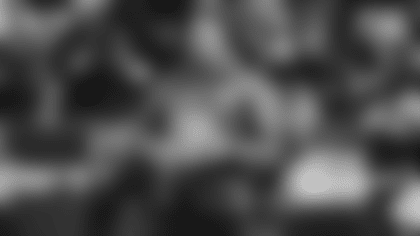Lee was the first of seven players drafted by the Packers Sunday.
One thing the Green Bay Packers didn't do Sunday was stand still.
On the second day of the 2003 NFL Draft the Packers made three trades on their way to picking seven players, four on defense and three on offense, including a return specialist.
To their first-day picks of linebacker Nick Barnett and defensive lineman Kenny Peterson, the Packers added Oregon State defensive tackle James Lee, Vanderbilt linebacker Hunter Hillenmeyer, Notre Dame tackle Brennan Curtin, Louisville cornerback Chris Johnson, South Florida wide receiver/return specialist DeAndrew Rubin, Toledo wide receiver Carl Ford and Carson-Newman linebacker Steve Josue.
The Packers' nine selections were the most since 2000, when they drafted 13 players.
The Packers actually had 11 selections going into this year's draft, but traded two of those picks away over the course of the weekend, plus a sixth-round pick in 2004.
GM/Head Coach Mike Sherman said before the draft that it was his goal to make every pick count. However, he also allowed that if 11 rookies made the season-opening 53-man roster, it would suggest that the Packers had a lackluster group of returning players.
On that note, at the conclusion of the draft Sunday, Sherman didn't predict that all nine draftees would make the 53-man roster, but he refused to rule any of them out.
"Every time that we took a player, I said, 'That guy has a chance to make our team,'" Sherman said. "I'm not sure I could have said that with 11 (picks), but I can say that with the nine. I'm excited about every one of them.
"It remains to be seen what their commitment is and how they fit in with the Green Bay Packers, but we had some good quality picks (that will make it) a very competitive camp. And that makes you a better football team."
The following is an overview of the Packers' seven second-day draft picks:
James Lee -
Standing 6-foot-4 and tipping the scales around 330 pounds, James Lee has the size the Packers covet at defensive tackle.
He also has the speed. Packers scout Sam Seale said Lee dropped under 5 seconds in the 40-yard dash and showed in games the ability to get off the line of scrimmage.
The Packers had to trade up to get Lee, swapping fifth-round picks with the Seattle Seahawks and giving up a sixth-round selection (203) to move from 165th to 147th overall.
The Packers had Lee tabbed as a fifth-rounder from the very beginning, but moved up based on the draft board.
"We felt like we had to move to go get him because he was really one of the only big-bodied guys left," said John Schneider, personnel analyst to the GM.
"I'm sure a lot of people would feel like hey, maybe the sixth round is a great spot to take the guy, but we couldn't wait."
The Packers admit that in some ways taking Lee is a gamble.
In two seasons at Oregon State, Lee was a regular contributor who made 38 tackles but never made it into the starting lineup.
Schneider said that was due to a number of factors, from Lee's junior college background to OSU's talented supporting cast.
But if not all the statistics pointed in Lee's favor, his physical traits just couldn't be ignored.
"This is definitely a guy with potential," Schneider said. "In the fifth round, that's kind of an area that you can take a shot on a guy like that."
Lee himself admitted that in the past he has exhibited a sub-par work ethic. But Sherman expressed confidence that the Packers' coaching staff will polish the 23-year-old's rough spots.
"If I didn't have faith in Jethro Franklin as a defensive line coach, I wouldn't have done this, but I think he can get it out of this guy," Sherman said.
"I'm taking a chance on this kid. I told him that. I said, 'You've got to get your butt in shape. I promise you, you've probably never been in shape the way we're going to get you in shape.'
"He's in for it. He's going to be awakened."
Hunter Hillenmeyer -
For NFL teams, the annual scouting combine in Indianapolis is an invaluable part of draft preparation. But it isn't fail-safe.
That the Packers were able to draft Hunter Hillenmeyer in the fifth round may have been due to some cracks in the system.
Trading to Philadelphia draft picks in the sixth (185) and seventh (244) rounds, the Packers earned the 166th overall selection and drafted a linebacker who led the Southeastern Conference with 168 tackles in 2002.
"Sometimes guys get lost in this thing," said John Dorsey, the Packers' director of college scouting. "I'm looking at guys that went ahead of (Hillenmeyer) and I'm going, 'These guys don't make as many plays as (he does).'"
At 6-foot-3 and 241 pounds, Hillenmeyer is a big-framed linebacker with speed to the football. He impressed Packers coaches with a short-shuttle run of 4.07 seconds, equal to that of their first-round pick, Nick Barnett.
The Packers also like Hillenmeyer's smarts.
A double-major at Vanderbilt in economics and human and organizational development, Hillenmeyer has already turned in his final college paper and hopes to graduate in May with a 3.8 GPA.
He's a quick-study on the football field, too, having shifted from outside to middle linebacker his senior season. The Packers will try him first at middle, but also believe he could play on the strong side.
"He's very big in the lower body, has great legs," Sherman said. "I think he'll be a player in this league for a long time."
Brennan Curtin -
If the Packers felt going into the 2002 season that it was important to have depth along the offensive line, you can imagine how they felt afterward, having seen both Mark Tauscher and Chad Clifton finish the year on injured reserve.
The Packers expect both starters to return in 2003, but bolstered their depth nonetheless selecting Notre Dame tackle Brennan Curtin in the sixth round with the 212th overall pick.
At 6-foot-9, 318 pounds, Curtin is a monstrous figure who the Packers had rated as a third-rounder.
"I think he's a terrific prospect," said Packers offensive line coach Larry Beightol. "I'm ecstatic about getting this guy with our sixth pick. I think it's a steal."
Beightol said in his 36-year career he's never coached a player as tall as Curtin, but he's excited to start.
"He's a very good athlete for someone of his size," Beightol said. "He plays with leverage, that's what shocks me."
The Packers plan to use Curtin at right tackle, where Tauscher, Earl Dotson and Kevin Barry saw time last season.
"There's nothing wrong with having too many good players," Beightol said.
Chris Johnson -
In the NFL, speed is always valuable. In the later rounds of the NFL Draft, it's golden.
Trading a sixth-round pick in the 2004 draft to Philadelphia, the Packers selected cornerback Chris Johnson of Louisville in the seventh round (245).
According to Sherman, Johnson timed out as the fastest player in the draft this year with a 40-yard dash time between 4.18 and 4.23, depending on who you ask.
"Once you get into that speed, I don't think you need to worry about anything else," Sherman said. "All I know is, it's fast."
Sherman called Johnson a "prototype" corner, but said the former junior college transfer's bump-and-run technique is "rusty."
"But, boy can he run," Sherman said.
Although they had three seventh-round picks remaining, the Packers traded up to take Johnson at 245 because they were confident the Oakland Raiders would claim him at 246.
Their hunch may have been correct, as the Raiders followed by taking defensive back Siddeeq Shabazz of New Mexico State.
DeAndrew Rubin -
In Gari Scott, signed April 11, Sherman thinks he may already have solved the Packers' punt returning woes of 2002, while adding depth at wide receiver at the same time.
But that doesn't mean DeAndrew Rubin won't get a shot.
As a senior at South Florida, Rubin returned 29 punts for a school-record 432 yards and two touchdowns.
Sherman said Rubin was worth a seventh-round pick because he can return both punts and kickoffs. But no matter how dangerous Rubin is as a return man, he'll be fighting an uphill battle to make the Packers' roster if he can't add depth at receiver as well.
"Whether he's someone that I will feel confident enough in to have him active on game day ... we'll have to wait and see," Sherman said. "It's a little bit of a risk, it always is, when you deal with those specialists.
"This young man says he's going to play receiver for me. We'll see. I hope he's right. God bless him, I hope he can."
Carl Ford -
Back in 1999, few expected greatness when the Packers spent a seventh-round draft pick on a wide receiver from Alcorn State named Donald Driver.
Likewise, the expectations won't be sky-high for Toledo wide receiver Carl Ford, who the Packers selected Sunday with the 256th overall pick.
Ford is one of 20 draft-eligible players that visited the Packers in Green Bay this spring, and Sherman said he took an immediate liking to the 22-year-old.
"(He's) really a neat kid," Sherman said. "I really fell in love with him ... (He) caught a bunch of balls in the offense, runs well, reminds me of a Donald Driver."
Ford has some kickoff return experience, but will be looked at primarily as a receiver.
At 6-foot-1, 170 pounds, Ford is a lanky player who caught 79 passes for 1,062 yards last season.
Steve Josue -
At least eight teams had expressed interest, but as the draft wound down to its final picks, Steve Josue wasn't sure whether he would get drafted.
"I didn't know what to expect," he said. "I was just being patient, being humble ... I was kind of nervous at first, and then I just let everything fall into place. Come to find out, here I am: drafted."
The Packers made their ninth and final pick of the 2003 draft on Josue, a linebacker from Tennessee's Carson-Newman College.
Standing 6-foot-2 and weighing 225 pounds, Josue has 4.4 speed in the 40 and was the defensive MVP of the Cactus Bowl.
Although he doesn't come out of a top-shelf college program, Sherman liked Josue's measurables enough to give him a chance.
"He's a very fast linebacker," Sherman said. "He's raw, but I think he's someone we can work with."














